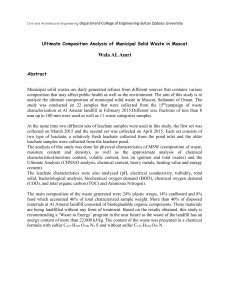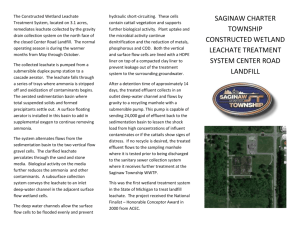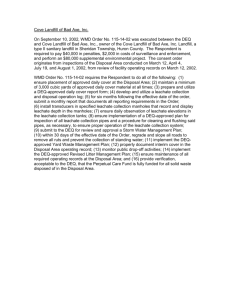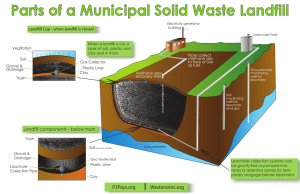Over the last years, the high population growth rate, industrialization... urbanization, have been the causes for several environment all over... CHAPTER 1
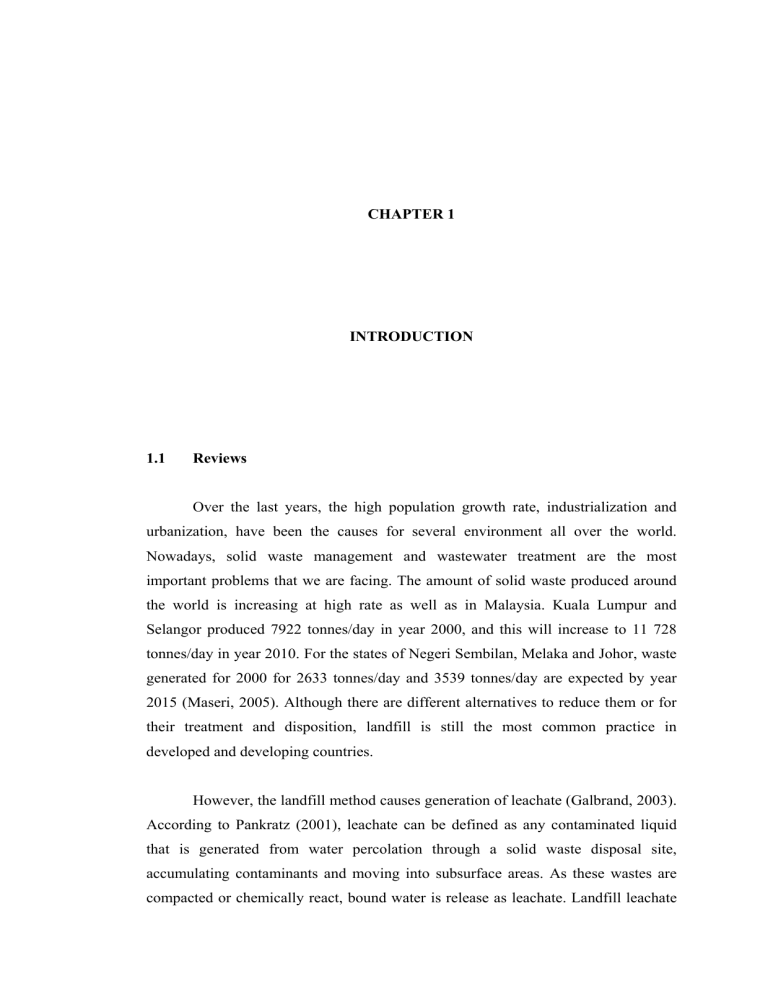
CHAPTER 1
INTRODUCTION
1.1 Reviews
Over the last years, the high population growth rate, industrialization and urbanization, have been the causes for several environment all over the world.
Nowadays, solid waste management and wastewater treatment are the most important problems that we are facing. The amount of solid waste produced around the world is increasing at high rate as well as in Malaysia. Kuala Lumpur and
Selangor produced 7922 tonnes/day in year 2000, and this will increase to 11 728 tonnes/day in year 2010. For the states of Negeri Sembilan, Melaka and Johor, waste generated for 2000 for 2633 tonnes/day and 3539 tonnes/day are expected by year
2015 (Maseri, 2005). Although there are different alternatives to reduce them or for their treatment and disposition, landfill is still the most common practice in developed and developing countries.
However, the landfill method causes generation of leachate (Galbrand, 2003).
According to Pankratz (2001), leachate can be defined as any contaminated liquid that is generated from water percolation through a solid waste disposal site, accumulating contaminants and moving into subsurface areas. As these wastes are compacted or chemically react, bound water is release as leachate. Landfill leachate
2 refers to the liquid that seeps through a landfill site and enters the environment. This liquid may already be in the material dumped into the landfill, or it may be the result of rainwater entering the landfill, filtering through the waste material and picking up additional chemicals before leaking out into the environment. Landfill leachate that escapes from the environment is most likely to eventually mix with the groundwater near the site. The quantity of these leachates is small as compared to others wastewater, but their contents are extremely hazardous (Tizaoui, at el.
, 2006).
Landfills are potential threats to groundwater quality (Howard, 1997), the primary concern being the production and treatment of leachate (Eyles and Boyce,
1997). Major environmental problems have arisen from the production and migration of leachates from landfill sites and subsequent contamination of surrounding land and water (McBean et al., 1995). To prevent the adverse impacts of landfill leachate on aquatic life and degradation of water quality, landfill leachate has to be collected and treated before final discharge into the environment (Sartaj, 2001).
Conventional treatment systems are costly and require a long-term commitment. Moreover, the great variations in strength and flows of leachate as well as its toxic effect, due to presence of high concentrations of heavy metals and/or organic substances, make the use of these systems undesireable (Vesilind et al.,
2002; Tchbanoglous et al., 1993). Many landfill operators are now considering nonconventional systems such as engineered constructed wetlands, which are low energy, do not require chemicals, and can satisfactorily address the leachate management problems (Sartaj, 2002). However, the modern landfill sites require that the landfill leachate to be collected and treated. Since there is no method to ensure that rainwater cannot enter the landfill site, landfill sites must now have an impermeable layer at the bottom.
1.2 Constructed Wetland and Landfill
The role of wetlands in water resource management is fact gaining ground resulting in the construction wetlands in most developed countries. Constructed
3 wetlands are man-made system that involves altering the existing terrain to simulate wetlands conditions. They primarily attempt to replicate the treatment that has been observed to occur when polluted water enters the natural wetlands (Chew, 2006).
Constructed wetlands have been used as an attractive low-cost method for controlling water pollution from both point and nonpoint sources (Olson, 1992;
Mitsch, 1992). Dundabin and Bowmer (1992) have revealed that constructed wetland also show good potential for concentrating metals from industrial wastewaters.
Wetlands prevent the contamination of groundwater or to prevent groundwater from infiltrating into the wetland (Kadlec et al., 2000). As reported by Olson (1992), constructed and natural wetlands also can contribute in reducing heavy metal and nutrient significantly to watershed water quality. On the other hand, constructed wetlands are also used to improve or restore some water bodies such as rivers and water basins (Nairn and Mitsch, 2000; Mitsch et al., 2005 and Mitsch and Day,
2006).
Among the aquatic treatment systems, constructed wetlands have a greater potential in wastewater treatment because they can tolerate higher organic loading rate and shorter hydraulic retention time with improved effluent characteristics
(Chongrak and Lim, 1998).
The treatment of industrial and domestic wastewaters by passage through beds containing plants of the common reed
(Phragmites australis),
reedmace
(Typha latifolia),
or other species, has been widely practised in recent years, with varying degrees of success (Barr and Robinson, 1999). This has often been shown to limit the value of reed beds for treatment of raw landfill leachates. Engineered wetlands do however; have considerable capability for secondary polishing of leachates that have been pretreated in aerobic biological plants and for older leachates (Barr and
Robinson, 1999).
There are two types of constructed wetlands: free water surface (FWS) wetlands also known as surface flow wetlands) and subsurface flow (SSF) wetlands
(also known as root zone method wetlands or rock-filters) (Liehr et. al., 2000). FWS
4 systems consist of several basins or cells with the water surface being 0.12 – 2.0 metres above the substrate (Tousignant et. al., 1999).
However, both surface-flow and subsurface-flow constructed wetlands have been identified as promising technologies for the treatment of landfill leachate
(Kadlec and Knight, 1996). Constructed wetlands have a small ecological footprint, utilize “low-tech” technology, and have an aesthetic value similar to that of natural wetlands. The application of wetland technology for treating landfill leachate is still developing (Nivala, et al., 2006).
Wetland also was categorized in the Best
Management Practices (BMP) which is one of the best to reduce non-point source pollution (Ayob and Supiah, 2005).
1.3 Objectives of the Study
The aim of this study was to establish a diverse, self-sustaining, locallymodelled, native vegetation community bearing biological integrity treatment wetland site that effectively decontaminate the leachate input via phytoremediative, physiochemical and biophysical means. The hypothesis of this study is that “the selected native vegetation and vegetation establishment strategy will yield a successfully established site bearing biological integrity and that a naturalized system supporting biological integrity will effectively remediate the characterized contaminated leachate input”.
The purpose of this project was to evaluate the efficiency in the context of treating real landfill leachate on-site using a laboratory scale system. The more specific goals of the study are given below: a) To investigate the feasibility of applying free water surface constructed wetland system to treat landfill leachate containing high organic matters and nutrient, under different concentration of leachate;
5 b) To determine the relationship between removal efficiency and different hydraulic retention time (HRT).
1.4 Scope of Study
This study comprises of a series of laboratory scale experiment. Leachate from a municipal solid waste landfill will be used. This study will cover: a) A laboratory scale wetland which will be developed for the treatment of leachate; b) Each system contained 2 cells. Each cells were planted with same number of plant 40 no. to 80 no. of plant. c) The efficiency of landfill leachate treatment system is analysed in terms of ammonia nitrogen (NH
3
-N), nitrate nitrogen (NO
3
-N), orthophosphates
(PO
4
3), COD, manganese (Mn), and iron (Fe). HACH DR/4000 spectrophotometer equipment was used for analysis of each particular parameter; d) The vegetation species that was used in this study is
Limnocharis flava
; e) All experiments were carried out in Environmental Engineering Laboratory,
Faculty of Civil Engineering, Universiti Teknologi Malaysia.
As cities are growing in size with a rise in the population, the amount of waste generated is increasing becoming unmanageable. The local corporations have adapted different methods for the disposal of waste such as open dumps, landfills,
6 sanitary landfills, as well as incineration plants. Besides, landfilling methods will generate a leachate and it will contaminate the groundwater table. These leachates may migrate from the refuse and contaminate surface and ground waters, which may affect human health and the aquatic environment. Treatment of these leachates in classical wastewater treatment plants is rarely practiced due to the nature and high levels of pollutants present in them (i.e. high COD, low biodegradability, heavy metals, pathogens, etc.). Dedicated treatment facilities are therefore required before the leachate being discharged to the environment or to the sewer system. As an alterative, constructed wetlands are suitable for treating leachate from landfill sites which can be very harmful if not treated properly. The problem with leachate treatment is that leachate changes in terms of strength, biodegradability, and toxicity as the wastes in the landfill age over time. Also, bearing in mind that landfilled wastes may take up to a hundred years to stabilize.
